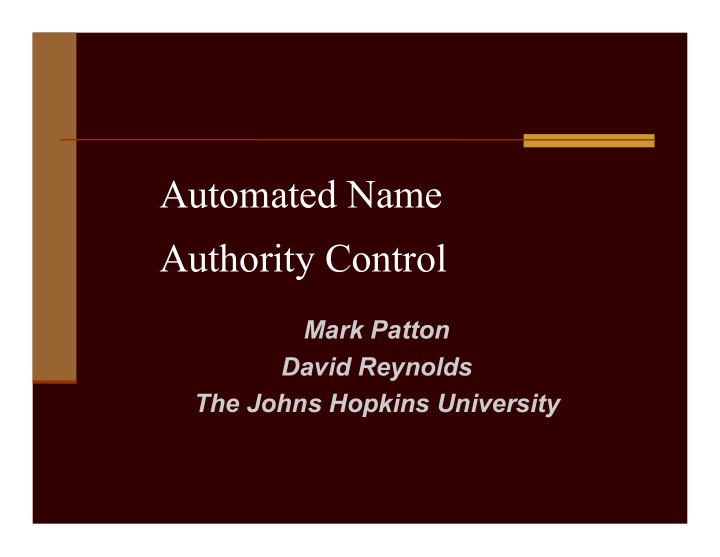



Automated Name Authority Control Mark Patton David Reynolds The Johns Hopkins University
Why do we need automated name metadata remediation? Inconsistent name representation Metadata harvested from multiple providers Hand-crafted data is expensive Commercial alternatives are expensive
ANAC background 29,000 Levy sheet music records 13,764 unique names 3.5 million LC name authority records (at the time of the project)
ANAC Architecture Levy records stored as individual XML files MARC records stored in MySQL TCL scripting language Ease of implementation
Problems with Levy data XML included some .html-like presentation information Names had to be extracted ANAC name extractor introduced error Date and location elements with bad data
Problems with LC data Matching on family name slow Not all Levy names represented in database MARC record format cumbersome
Ground truth generation Catalogers checked 2,841 random names from Levy against LC authority file Used evidence such as name, date, notes, other publications Took approximately 7 minutes per name 28% did not have matching LC record
ANAC Rank LC records by confidence Limit match possibilities to same family name Bayesian classifier calculates confidence based on evidence Names below a minimum confidence declared no match Train on ground truth data
Data: Levy records Given name Middle name Family name Modifiers Date Location
Data: LC records Given names Middle names Family name Modifiers Birth & death dates Context
Evidence Name equality and consistency Musical terms in LC record Publication date consistent with birth/death Publication place consistent with LC record New evidence can be added easily
Test results Average Std. dev. Accuracy 0.58 0.00 Accuracy (LC 0.77 0.00 record exists) Accuracy (LC 0.12 0.00 record does not exist)
Observations Matching very dependent on contextual data Machine matching much faster than manual Performance reasonable even with dirty metadata Machine matching could enhance manual work
Conclusions Combination of machine processing and human intervention produced best results Approach could be tweaked by comparing names to multiple authority files or domain specific databases ANAC not a generalizable tool, but others are out there
Related Software Weka http://www.cs.waikato.ac.nz/ml/weka GATE http://gate.ac.uk/ UIMA http://www.research.ibm.com/UIMA/ LingPipe http://www.alias-i.com/lingpipe/
Relevant links Patton, Mark, et al. (2004). “Toward a Metadata Generation Framework: A Case Study at Johns Hopkins University” D-Lib Magazine 10, No. 11 (November) <doi:10.1045/november2004- choudhury > DiLauro, Tim G., et al. (2001). “Automated Name Authority Control and Enhanced Searching in the Levy Collection” D-Lib Magazine 7, No. 4 (April) <doi:10.1045/april2001-dilauro>
Discussion Questions How important is consistent name entry? Would it be more important for some communities than others? What types of domain-specific information might be available in OAI metadata that would help cluster names? What successes and/or failures have you had with automated name-authority control?
Recommend
More recommend